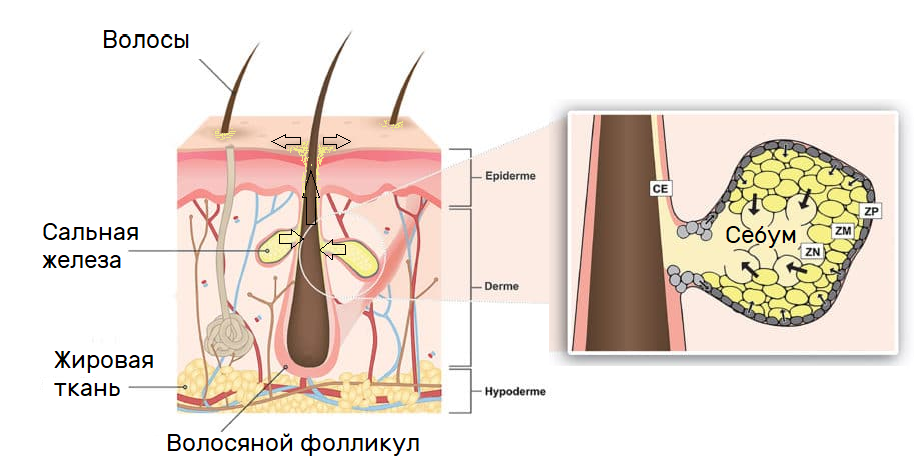Acne, also known as pimples or acne vulgaris, is a common, chronic (according to doctors) skin condition characterized by the formation of pimples, comedones (blackheads and whiteheads), papules, and pustules. This is due to excess secretion of sebum from the sebaceous glands, the skin lipids that lubricate the skin (Figure 1).

There is a popular understanding that acne is a problem of teenagers during puberty, but this is not entirely true; acne also occurs in adults, in old people, it occurs from medications (drug-induced acne), and it even occurs in newborns ( neonatal acne).
If you ask doctors about the causes of acne, you will hear the answer that they can be different. Some will say hormonal changes, some will say sensitivity of androgen receptors, some will say bacterial infections, some hereditary factors. But no one will tell you the specifics - the exact pathophysiology of acne.
Doctors were not taught this, and even those teachers who taught did not understand much, and do not understand to this day. I do not condemn too much, but it is a fact. They were taught that there is a sebaceous gland, it accumulates lipids, P. acnes bacteria start in them , and an inflammatory process begins. It's in the bag. But if someone had asked a question at a lecture - why does the sebaceous gland accumulate lipids or why only P. acnes lives in the sebaceous glands, then they probably would not have heard a clear answer from the lecturer. I have also been to such lectures, for lecturers such topics are not specialized, etc. This is a normal nuance of any education, but acne patients do not feel any better from this...
Acne treatment usually involves topical (external) medications, cosmetic dermatology procedures, and lifestyle changes. However, anyone who has treated acne knows that this does not always help (in girls, before the first period, in guys, before the first stress), and sometimes does not help at all. And such poor efficiency suggests that we need to look for the real causes of acne and more effective treatment methods. I once set myself this task and successfully solved it .
Я пришел к четкому выводу, что акне (а возможно и другие проблемы кожи, например розацеа и дерматиты) это проблема дезинтоксикации кожи. Да, кожа это орган. Об этом я сделал детальную научную статью, но на пути к публикации стали некоторые «барикады» :). Как сказал один умный человек — «Теперь разумные учатся говорить так, чтобы тупым было понятно. Если тупой что-то не понял, это проблема разумного.»

Но как бы там ни было, я надеюсь мою публикацию об истинных причинах акне скоро увидит мир. Это было небольшое лирическое отступление, перейдем к сути.
Патофизиология акне
Давайте я опишу как связать все виды акне с проблемами дезинтоксикации. А информация о методах коррекции акне в моих гайдах, об этом я не буду писать открыто.
И так, мы знаем такие основные виды акне:
- Акне подростков
- Акне новорожденных
- Акне взрослого человека
- Хлоракне (или акне от диоксинов)
У всех этих акне общее это повышение секреции сальных желез, или другими словами больше кожного сала на поверхности кожи. Это сало очень любят кушать разные организмы на коже, от клещей до бактерий и грибков. Т.е фактор микрофлоры на коже вторичный. Его я не рассматриваю вовсе.
Акне подростков. У них происходит половое созревание, что подразумевает повышения факторов роста (например IGF-1) и половых гормонов (например тестостерон). Факторы роста отвечают за пролиферацию (деление) клеток, в том числе и себоцитов (клетки что создают себум) в сальных железах, а вот половые гормоны это липиды синтезированные внутри других желез организма, что нужно как-то утилизировать с организма. Если не происходит утилизация, метаболиты половых гормонов повторно вступают в метаболизм (снова воздействуют на ткани).
Другими словами, у людей с подростковым акне чаще всего уровень половых гормонов настолько большой, что органы выведения (печень, кишечник, почки) не справляются с утилизацией, им начинает помогать кожа, а именно сальные железы в ней. Именно поэтому кожа подростков стает жирной, и на ней может заводится плохая микрофлора, что в сумме приводит к акне. Именно поэтому любая нагрузка на печень и на кишечник ведет к обострению акне. Отсюда и рекомендации диеты при акне. Любая жирная еда\алкоголь\токсины дают обострение акне при нарушении утилизации липидов организмом. Это не причины акне, а сопутствующие факторы.
Акне новорожденных. Бытует мнение что акне новорожденных это влияние андрогенов в утробе матери. От части этот так, в утробе матери на плод влияют разные факторы в том числе и липидные гормоны, липидные токсины и т.д. и т.п. Это на самом деле плохо и возможно ведет к девиациям у ребенка в частных случаях.. Однако акне новорожденных может появиться через время после рождения, есть фактор, что возникает после рождения.
Ответ довольно простой, мать ребенка начинает кормить его грудью, и с молоком матери в организм попадают всевозможные липидные вещества. Кто-то например разрешает давать матери л-тироксин при кормлении грудью. Видел как врач-эндокринолог писала что можно, протоколы позволяют, мрак одним словом… Или у матери уже были какие-то гормональные нарушения, что привели к повышению гормонов в молоке. Или была какая-то диета. В любом случае выделительные органы ребенка не справляются с такой нагрузкой, подключается кожа и ее сальные железы для вывода этих веществ. Случается неонатальное акне. На это акне даже может повлиять некачественная одежда ребенка или посуда. Ведь в таких изделиях могут быть бисфенолы, которые попадают в организм трансдермально в пико дозах, которых вполне достаточно для метаболизма ребенка.
Акне взрослого человека. У таких людей обычно все ОК с гормонами, однако есть хроническое акне. Также акне обычно не только на лице, но и на спине. Причины тут такие же как в прошлых пунктах, однако следует установить, что дает интоксикацию организма. Это могут быть вредные привычки (например вейпы, плохая еда), это может быть экология (не покупайте жилье возле дорог с большим трафиком), это могут быть заболевания ЖКТ (а именно нарушение желчеотделения и проницаемость тканей кишечника). Факторов что нарушают метаболизм липидов много, но их следует установить путем диагностики или методом тыка, исключая разные варианты (я понимаю что методы диагностики зачастую ограничены).
Хлоракне. Это жуткое акне обычно возникает у работников заводов, что имеют дело с диоксинами. Яркий пример такого акне был у В. Ющенко, после отравления чекистами, что подсыпали ему в еду 2,3,7,8-Тетрахлородибензодиоксин или ТХДД. Хлоракне по сути является ярким подтверждением моих слов, — кожа активирует сальные железы чтобы избавится от токсинов. Однако в случае контакта с диоксинами происходит не просто активация сальных желез, а и ускоренная пролиферация их себоцитов, т.е сальные железы сильно увеличиваются в размерах. Отсюда и кистозная картина такого акне.
Молекулярные пути акне
In addition to ordinary people, I am also read by specialists. I think they want details in terms of molecular cascades that trigger the detoxification I write about. No problem, I will tell you that you need to pay attention to lipid-activated transcription factors. For example, this is AHR (aryl hydrocarbon receptor) aromatic hydrocarbon receptor, farnesoid X receptor (FXR), liver X receptor (LXR), pregnane X receptor (PXR) and peroxisome proliferator-activated receptor alpha (PPAR-alpha) . All these receptors have lipid ligands. Activation of these receptors leads to the launch of detoxification phases in different cells, and in sebocytes leads to sebum accumulation. In fact, research into these receptors prompted me to solve the problem of acne pathophysiology.
Of course, these receptors have long signaling pathways, and a failure somewhere in the chain can also cause acne, even without any special external factors. For example, there are polymorphisms in the genes of the above-described receptors, as well as polymorphisms in the genes of intracellular enzymes that are activated through lipid-activated transcription factors (Gilbert's syndrome is a striking example).
Acne treatment
If a person has many inflammatory elements, first of all it is necessary to suppress this inflammation with antibiotics. Then all treatment should be aimed at improving detoxification in the gastrointestinal tract and in the skin, it is also necessary to eliminate any anomalies in terms of excessive secretion of lipid hormones. No cosmetics are needed for this! Getting rid of acne with this approach can take from 3 months to a year. Full instructions in my guides .


